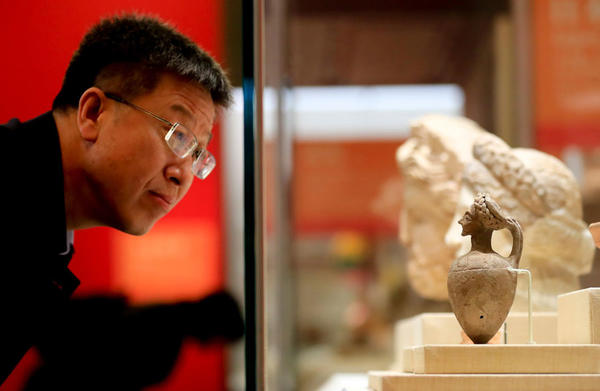Landmark Exhibition Projects Asia's Cultural Richness

A visitor tours The Splendor of Asia: An Exhibition of Asian Civilizations at National Museum of China in Beijing on Monday. [Photo by Du Yang/China News Service]
The curtain was raised on a major exhibition at National Museum of China in Beijing on Monday that presents the great wealth and diversity of Asian cultures.
The Splendor of Asia: An Exhibition of Asian Civilizations, which continues through August 11, offers visitors a journey across the vast lands of the continent and travel through its long history by presenting 451 cultural relics from 49 countries.
It is also a key event to mark Wednesday's opening of the Conference on Dialogue of Asian Civilizations. "Different countries closely cooperated with each other for this exhibition," said Guan Qiang, deputy director of the National Cultural Heritage Administration.
"Such a large number of top-level exhibits and participating countries have never been seen before in one exhibition in China," Guan said.
From a human figurine from Saudi Arabia dating back 7,000 years to a Buddha statue from Pakistan and a perfume bottle from the United Arab Emirates, both from about the third century AD, people's daily life and aesthetics from early civilizations are vividly portrayed.
A sixth-century pottery statue of a Japanese farmer may amuse visitors with his smiling face while a 10th-century image of Ganesha, the elephant-head deity in Hinduism, will probably remind people of its power with its strong nose and thighs.
Some modern artworks are also displayed.
"Asia is the most populous continent with the greatest ethnic diversity," Luo Shugang, minister of culture and tourism, said at the opening ceremony of the exhibition. "The history of the past millennia has witnessed ancient civilizations rise and thrive along the Yellow and Yangtze rivers, the Indus and the Ganges, the Euphrates and the Tigris, as well as in Central and Southeast Asia."
Even for Chinese history fans who frequently visit museums, it is uncommon to see such a large group of Chinese national treasures in a single exhibition.
In the exhibition, there is cong, the 5,000-year-old ceremonial jade article from Liangzhu in Zhejiang province, large oracle bones, the earliest-known written Chinese characters dating back 3,000 years, and pages from Yongle Dadian, the world's largest encyclopedia on paper, from the Ming Dynasty (1368-1644).
Even Greece and Egypt, two non-Asian countries with great ancient civilizations, have loaned artifacts to the exhibition due to their close links and mutual influences with Asia throughout history.
Many of the exhibits reflect the prosperity of the ancient network of trade routes traversing the continent.
For example, Nasrin Belali, an exhibition curator from the National Museum of Afghanistan, chose to take a glass jar that was unearthed along the route of the Silk Road, as well as a Buddhist statue. "We have a long and good relationship with China thanks to the Silk Road, which means our cultures are related," she said.
The Afghan museum's Bactrian Gold collection - a hoard of gold ornaments from the first century BC to the first century AD - has toured Chinese museums since 2017, reflecting the ancient culture of the country, which is a mix of East and West.
Kennie Ting, director of the Asian Civilisations Museum in Singapore, noted that some exhibited porcelains from his museum were originally from China. "We'd like to show ancient maritime trade and our connection with China," he said.
